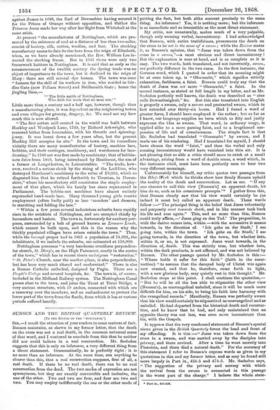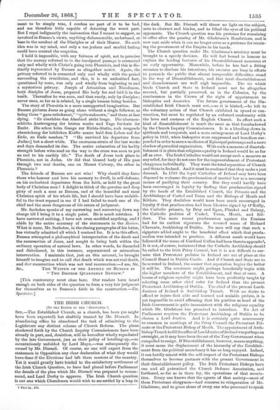BUNSEN AND THE BRITISH QUARTERLY REVIEW.
[TO THE EDITOR OF THE "SPECTATOR."] SIR, —I recall the attention of your readers to some matters of fact. Bunsen maintains, as shown in my former letter, that the death on the cross was not a real death, in the common universal sense of that word, and I ventured to conclude from this that he neither did nor could believe in a real resurrection. Mr. Seebohm suggests that this is only an inference, a very different thing from a direct statement. Grammatically, he is perfectly right : it is no more than an inference. At the same time, can anything be clearer than this, that a real resurrection supposes, first of all, a real death. If there be no real death, there can be no real resurrection from the dead. The two modes of expression are not synonymous, but they are exactly convertible and inclusive, the one of the other. Two and two are four, and four are two and two. You may employ indifferently the one or the other mode of
putting the fact, but both alike amount precisely to the same thing. An inference ! Yes, it is nothing more ; but the inference is as immediate and as irresistible as the moat direct statement.
My critic, not unnaturally, makes much of a very palpable, though only seeming verbal, inconsistency. I had acknowledged that Bunsen, with entire truthfulness, pronounces the death on the cross to be not in the sense of a swoon; while the Review states it, as Bunsen's opinion, that "Jesus was taken down from the cross in a swoon,"—a most obvious and direct inconsistency ! But the explanation is near at hand, and is as complete as it is easy. The two words, both translated, and not incorrectly, swoon, are perfectly different in the two cases. In the first instance, the German word, which I quoted in order that its meaning might be at once taken up, is " Ohninacht," which signifies strictly exhaustion, feebleness, a faint. Bunsen could truly say that the death of Jesus was not mere " Ohnmacht," a faint. In the second instance, as stated at full length in my letter, and as Mr. Seebohm perfectly well knows, the death was described as " eine voile Bewustlosigkeit," &G. But this also translated into English is properly a swoon, only a severe and protracted swoon, which in fact extended over thirty-six hours. Had I found a word of greater force, I should have employed it the rather ; but so far as I know, our language supplies no term which so fitly and justly expresses the idea as swoon. That word, in ordinary usage, is applied alike to a mere passing faint, and to a lengthened sus- pension of life and of consciousness. The simple fact is that Mr. Seebohm had translated " Ohnmacht " by swoon, and I made use of his rendering. Had I translated for myself, I should have chosen the word "faint," and then the verbal and only seeming inconsistency would have vanished into thin air. It is not pleasing that so able a critic should seem to catch at a small advantage, arising from a word of double sense, a word which, in the instances cited, must have been perfectly seen to bear two very different meanings.
Unfortunately for himself, my critic quotes two passages from the Bibel-Werk which he thinks show how firmly Bunsen upheld the reality of the death and resurrection. Let us see. " If any one chooses to call this view [Bunsen's] an apparent death, let him do so, each as his conscience prompts."* I gather from this, that Bunsen clearly saw that his view would certainly be (as indeed it must be) called an apparent death. These words follow :—" The principal thing is the belief that Jesus voluntarily and purposely went towards death, and in like manner took back his life and rose again." This, and no more than this, Bunsen could truly affirm,—' Jesus ging en den Tod.' The preposition, in with the dative means into, within —with the accusative it means towards, in the direction of. 'Ich gehe en der Stadt,' I am going into, within the town. Ich gehe en die Stadt,' I am going towards, in the direction of the town, but whether into, within it, or no, is not expressed. Jesus went towards, in the direction of, death. This was strictly true, but whether into, within the dark precincts, is not affirmed, and was not believed by Bunsen. The other passage quoted by Mr. Seebohm is this :- " Whoso holds it safer for this faith" (faith in the resur- rection) " to assume that the decayed body of Christ was again new created, and that he, therefore, came forth to light, with a new glorious body, may quietly rest in this thought." Mr. Seebohm stops at this point. I shall continue the quotation,- " But he will be all the less able to stigmatize the other view (Bunsen's), as unevangelical unbelief, since it will be much more difficult for him, on his side, to bring his faith into harmony with the evangelical records." Manifestly, Bunsen was perfectly aware that his view would certainly be stigmatized as unevangelical and as unbelief. He had departed from the historical death and resurrec- tion, and he knew that he had, and only maintained that an opposite theory was not less, was even more inconsistent than his, with the Gospels.
It appears that the very condensed statement of Bunsen's special views given in the British Quarterly forms the head and front of my offending. It is this :—" Jesus was taken down from the cross in a swoon, and was carried away by the disciples into privacy, and there revived. After a time he went secretly into Phoenicia, and there died a natural death." For the accuracy of this statement I refer to Bunsen's express words as given in my quotations in this and my former letter, and as may be found still more largely in Part ix., 434-5 and 474-5. Mr. Seebohm says, " The suggestion of the privacy and secrecy with which the revival from the swoon is connected in this passage is the worst part of the charge." I believe the whole state-
• Part ix., 425-126.
ment to be simply true, I confess no part of it to be bad, and am therefore little capable of detecting the worst part. But I repel indignantly the insinuation that I meant to suggest, as involved in Bunsen's views, anything dishonourable, underhand, or base in the conduct of the Disciples or of their Master. No such idea was in my mind, and only a too jealous and morbid feeling could have created the suspicion.
I hold it impossible, with any fairness of spirit, not to perceive that the secrecy referred to in the inculpated passage is connected only and wholly with Christ's going into Phoenicia, and this is dis- tinctly represented by Bunsen as altogether secret. Again, the privacy referred to is connected only and wholly with the period succeeding the crucifixion, and this, it is an undoubted fact, questioned by none, was only and wholly from beginning to end a mysterious privacy. Joseph of Arimathea and Nicodemus, both disciples of Jesus, prepared His body for and laid it in the tomb. Thereafter he was seen, and that rarely, only by disciples ; never once, so far as is related, by a single human being besides.
The story of Phoenicia is a mere unsupported imagination. But Bunsen pictures Jesus as going alone without a single follower, as being there " ganz unbekanut," "quite unknown," and there at last dying. "Er iiberlebte den Abschied nicht lauge. Die iibermen- schliche Anstreugung der letzten woche and Tage furderte ihr Becht. Die schon beim Gauge zur Richts-Statte, zech zeugende absurachung der leiblichen Kriifte muste bald dem Leben auf der Erde, an Ende machen."t "He survived his departure from Judma] but a short while. The enormous strain of the last weeks and days demanded its due. The entire exhaustion of his bodily strength before witnessed on the way to the cross was soon to put an end to his earthly life." The death of Jesus took place in Phoenicia, not in Judea. Or did that blessed body of His pass through two real deaths, one on Mount Calvary, the other in Phoenicia ?
The friends of Bunsen are not wise ! Why should they force those who honour and love his memory to dwell, in self-defence, on his undoubted departures from the faith, as held by the great body of Christian men ? I delight to think of the genuine and deep piety of such a man as Bunsen, and of the beautiful and most Christian spirit of his whole life, but I should have been unfaith- ful to the trust reposed in me if I had failed to mark one of the chief and the most dangerous of his errors of judgment.
Mr. Seeliohm speaks of my narrowing and narrowing down my charge till I bring it to a single point. He is much mistaken. I have narrowed nothing, I have not even modified anything, and I abide by the entire accuracy of the statements in the Review. What is more, Mr. Seebohm, in the closing paragraphs of his letter, has virtually admitted all which I contend for. It is to this effect. Bunsen attempted a philosophical interpretation of the death and the resurrection of Jesus, and sought to bring both within the ordinary operation of natural laws. In other words, he discarded and disbelieved, in this instance, supernatural or miraculous intervention. I maintain that, just on this account, he brought himself to imagine and to call that death which was not real death, and that resurrection which was not real resurrection.—I am, Sir,
&c., THE WRITER OF THE ARTICLE ON BUNSEN IN " THE BRITISH QUARTERLY REVIEW."
[This controversy must close here. Our readers have heard enough on both sides of the question to form a very fair judgment for themselves as to Bunsen's faith in the resurrection.—En. Spectator.]



































 Previous page
Previous page